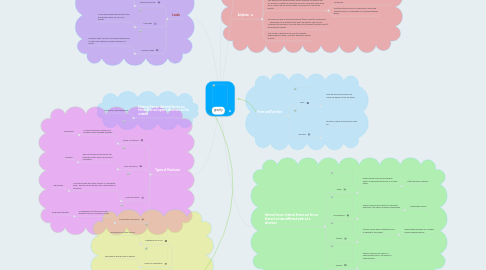
1. gravity
1.1. External Forces: External forces are forces that act upon a structure on the outside
1.1.1. e.g gravity, wind resistance
2. Types of Stuctures
2.1. Frame Structures
2.1.1. A frame structure is made up of different parts attached together
2.1.1.1. e.g bicycle
2.2. Shell Stuctures
2.2.1. Shell structures are hollow on the inside and often serve as excellent containers.
2.2.1.1. e.g igloo
2.3. Solid Structures
2.3.1. Solid structures are usually almost or completely solid, and are usually heavier than other types of stuctures
2.3.1.1. e.g boulder
2.4. Combination Stuctures
2.4.1. Combination structures are many different types of structures in one
2.4.1.1. e.g human skeleton
3. Loads
3.1. Static/Dead loads
3.1.1. Static load is the load caused by gravity.
3.2. Live loads
3.2.1. A live load is what the structure was designed to hold, e.g cars on a bridge.
3.3. Dynamic loads
3.3.1. Dynamic loads can vary and change depending on the force applied, e.g wind blowing on a house.
4. Applying forces
4.1. Magnitude Of Force
4.1.1. how hard or soft the force is
4.2. Plane Of Application
4.2.1. the angle at which force is applied
4.3. Direction of application
4.3.1. the direction at which force is applied from
4.4. Point Of Application
4.4.1. where on the structure where force is applied
5. External forces are forces coming from outside of the structure, causing change to the structure
5.1. wind resistance
5.2. gravity
5.2.1. the centre of gravity is where all of the mass of an object is concentrated, the object would be perfectly balanced if it was supported on that point
6. Internal forces: Internal forces are forces that act on two different parts of a structure
6.1. Shear
6.1.1. When parallel forces are pulling an object in opposite directions, it is under shear.
6.1.1.1. cutting a piece of paper
6.2. Compression
6.2.1. When forces push an object in opposite directions, the object is being compressed.
6.2.1.1. squeezing a lemon
6.3. Torsion
6.3.1. Torsion occurs when rotational force is applied to the object.
6.3.1.1. spinning the propeller on a rubber band powered airplane
6.4. Tension
6.4.1. When forces pull an object in opposite directions, the object is under tension.
7. Form and Function
7.1. Form
7.1.1. How the structure is built and looks, the design of the structure
7.2. Function
7.2.1. Function is what a structure is used for
8. Airplane
8.1. Form
8.1.1. An airplane has two wings, usually 1-4 engines, a rudder and elevators at the back
8.2. Function
8.2.1. An airplane is designed to carry people and or cargo from one location to another quickly by flying
8.3. Two external forces that always effect airplanes are gravity and lift. gravity is created by the earth and pulls the plane down while life is created by the planes wings and allows it to overcome gravity.
8.3.1. An internal force that an airplane will have to withstand is shear, the engines help pull the plane forward, thus making it possible that the engines will go flying off if they aren't properly reinforced.
8.3.2. Another internal force is compression. When the airplane lands, it compresses on its wheels/landing gears

